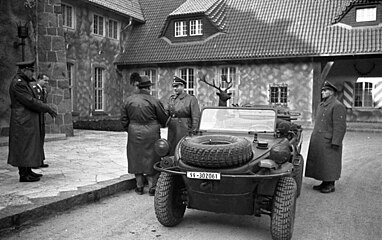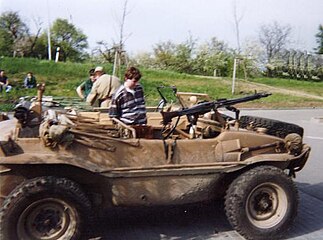
Volkswagen, abbreviated as VW, is a German automobile manufacturer headquartered in Wolfsburg, Lower Saxony, Germany. Founded in 1937 by the German Labour Front under the Nazi Party and revived into a global brand after World War II by the British Army officer Ivan Hirst, it is known for the iconic Beetle and serves as the flagship brand of the Volkswagen Group, the largest automotive manufacturer by worldwide sales in 2016 and 2017. The group's biggest market is in China, which delivers 40 per cent of its sales and profits. Its name is derived from the German-language terms Volk and Wagen, translating to "people's car" when combined.

The Volkswagen Beetle—officially the Volkswagen Type 1, is an economy car that was manufactured and marketed by the German company Volkswagen (VW) from 1938 until 2003. It has a rear-engine design with a two-door body style and is intended for five occupants.

Ferdinand Porsche was an Austro-Bohemian automotive engineer and founder of the Porsche AG. He is best known for creating the first gasoline–electric hybrid vehicle (Lohner–Porsche), the Volkswagen Beetle, the Auto Union racing cars, the Mercedes-Benz SS/SSK, and several other important developments and Porsche automobiles.

The Volkswagen Type 82 Kübelwagen, or simply Kübel, contractions of the original German word Kübelsitzwagen, is a military light utility vehicle designed by Ferdinand Porsche and built by Volkswagen during World War II for use by the Nazi German military. Based heavily on the Volkswagen Beetle, it was prototyped and first deployed in Poland as the Type 62, but following improvements entered full-scale production as the Type 82. Several derivative models, such as the Kommandeurswagen, were also built in hundreds, or in dozens.
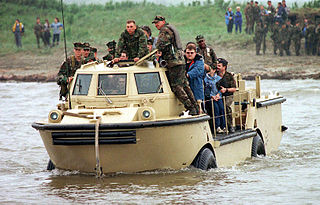
An amphibious vehicle, is a vehicle that is a means of transport viable on land as well as on or under water. Amphibious vehicles include amphibious bicycles, ATVs, cars, buses, trucks, railway vehicles, combat vehicles and hovercraft.

A transaxle is a single mechanical device which combines the functions of an automobile's transmission, axle, and differential into one integrated assembly. It can be produced in both manual and automatic versions.

Portal axles are an off-road vehicle suspension and drive technology where the axle tube or the half-shaft is off-set from – usually above – the center of the wheel hub and where driving power is transferred to each wheel via a simple gearbox, built onto each hub. This gives two advantages: ground clearance is increased, particularly beneath the low-slung differential housing of the main axles — and secondly, any hub reduction gearing allows the axle halfshafts to drive the same power but at reduced torque. This reduces load on the axle crownwheel and differential.

The Volkswagen Type 181 is a two-wheel drive, four-door, convertible, manufactured and marketed by Volkswagen from 1968 until 1983. Originally developed for the West German Army, the Type 181 also entered the civilian market as the Kurierwagen in West Germany, the Trekker in the United Kingdom, the Thing in the United States (1973–74), the Safari in Mexico and South America, and Pescaccia in Italy. Civilian sales ended after model year 1980.

The Porsche 114 was a 1938 proposed design for a sports car powered by a 1493 cc V10 engine.
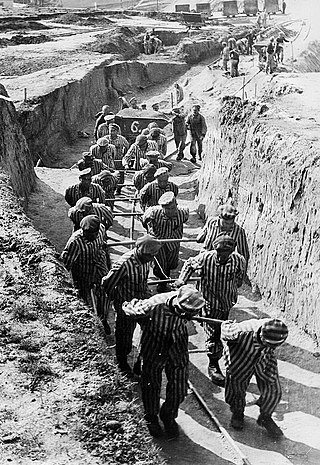
Arbeitsdorf ("work-village") was a Nazi concentration camp in Stadt des KdF-Wagens bei Fallersleben 1942.

The Volkswagen Country Buggy is a small utility vehicle designed and built by Volkswagen in Australia. It used parts from the existing Type 1 and Type 2. Production ran from 1967 to 1968. A derivative of the Country Buggy called the Sakbayan was built in the Philippines for several years until 1980.

In automobile design, a rear-engine design layout places the engine at the rear of the vehicle. The center of gravity of the engine itself is behind the rear axle. This is not to be confused with the center of gravity of the whole vehicle, as an imbalance of such proportions would make it impossible to keep the front wheels on the ground.

In automotive design, an R4, or Rear-engine, Four-wheel-drive layout places the internal combustion engine at the rear of the vehicle, and drives all four roadwheels.
The Volkswagen Type 276 Schlepperfahrzeug was a derivative of the Type 82 Kübelwagen modified to enable it to tow a load, gun or a trailer.

The Volkswagen Type 183, more commonly known as the Iltis, is a military vehicle built by Volkswagen for use by the German military. The Iltis was formerly built under licence in Canada by Bombardier Inc.

An amphibious automobile is an automobile that is a means of transport viable on land as well as on or under water. They are unarmored for civilian use.
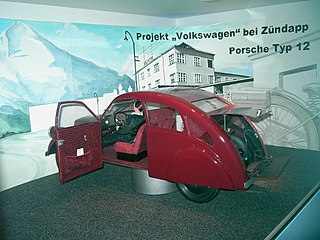
The Porsche Type 12 was a German project to develop an "Everyman's automobile" for Zündapp. Fritz Neumeyer, then owner of Zündapp, ordered Ferdinand Porsche to design and build the prototype in 1931. Eventually, two saloons, and one drophead coupé were built. All of those cars were lost during World War II, the last one in a bombing raid in Stuttgart in 1945. The Type 12 is considered an important early step in the development of the original Volkswagen. A replica of the Type 12 is on static display at the Museum Industrielkultur in Nürnberg.

The Volkswagen Typ 87, also known as the Kommandeurswagen, is a World War II, four-wheel-drive version of the Volkswagen Beetle. It was produced from 1941 to 1944 by the Volkswagen plant, primarily for high officers of the Wehrmacht. The Wehrmacht classified the Kommandeurswagen as leichter geländegängiger PKW, 4-sitziger, 4-radgetriebener Geländewagen Typ 87..

A platform chassis is a form of vehicle frame / automobile chassis, constructed as a flat plate or platform, sometimes integrating a backbone or frame-structure with a vehicle's floor-pan.

KFZ.1 Kubelwagen: Volkswagen Type 82 is a reference work published by Almark Publication in 1978 about a military vehicle used by German forces during World War II.



